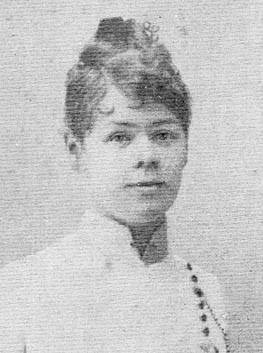Laura Marholm was an author and an essayist.
Laura Marholm was born Laura Mohr in Riga in 1854. Her father was Danish and her mother was German. She was an only child and was well-educated.
Her play called Frau Marianne was produced in Berlin in 1882. A few years later her interest turned towards Scandinavia and she published an essay on Ibsen. In April 1884 she made contact with Georg Brandes, after having read Hovedstrømninger i det 19de Aarhundredes Literatur. She spent the period of 1885–1886 in Copenhagen and Brandes became her spiritual mentor.
In May 1888 Laura Marholm published a review of Ola Hansson’s short-story collection entitled Sensitiva amorosa and the two of them met that summer at Brandes’ home. This eventually led to their marriage in the autumn of 1889. At that time they shared the same reading and other interests. They were both captivated by women’s and gender psychology and its complex problems. Laura Marholm also came up with the idea of systematically presenting and translating Scandinavian literature in Germany.
Thus, during the 1880s, Laura Marholm came to mainly publish articles on Scandinavian literature in German and Baltic journals. However, she developed her own authorship during the 1890s and produced essay collections and works of fiction such as Sex tidspsykologiska porträtt, from 1895, Fru Lilly som ungmö, maka och moder and Tvenne kvinnoöden, both from 1896, and Till kvinnans psykologi, from 1897. Her novel Fru Lilly som ungmö, maka och moder, subtitled Interiörer ur ett lif, follows Lilly Mayland’s search for a meaningful existence. Laura Marholm cleverly portrays a dinner party in a room in a bourgeois home full of young ladies each loaded with a subconscious and unexpressed longing to get out and away. The tragedy of their lives becomes clear when it becomes apparent that the only possibility for change on offer lies in marriage and that the women had little chance of influencing the choice of partner. What lay ahead was either to await an invitation or to remain in the corner. Lilly Mayland eventually meets a man whom she marries and in the final scene of the book she is in the countryside where she and her family live off the land. In this rural idyll their sons help out with the farm animals and the contrast between them and a few pale city-dwellers who come to the farm is striking. Laura Marholm portrays a family that turns away from the life-threatening environment of the city in favour of a farm at the bottom of a field with extensive views of hills, lakes and meadows. This novel highlights survival strategies which reject modern society and opt for other lifestyles.
Laura Marholm’s marriage to Ola Hansson became problematic during the 1900s. The couple moved around from area to area with their young son, sometimes living under very straightened conditions but finally finding a sanctuary at the Bosporus near Istanbul. Laura Marholm’s biographer Susan Brantly confirms however that around the turn of the 1900s Laura Marholm was a significant intellectual role model and “in the mid-nineties, Laura was much more widely read than her now famous contemporaries, Ellen Key and Lou Andreas-Salomé”. They were only briefly able to enjoy that status of “free intellectuals” with a good income, which they were seeking. When Ola Hansson was awarded stipends in the 1900s Laura Marholm was not equally lucky. Instead a certain silence grew up around her work.
Laura Marholm died in Latvia in 1928.












